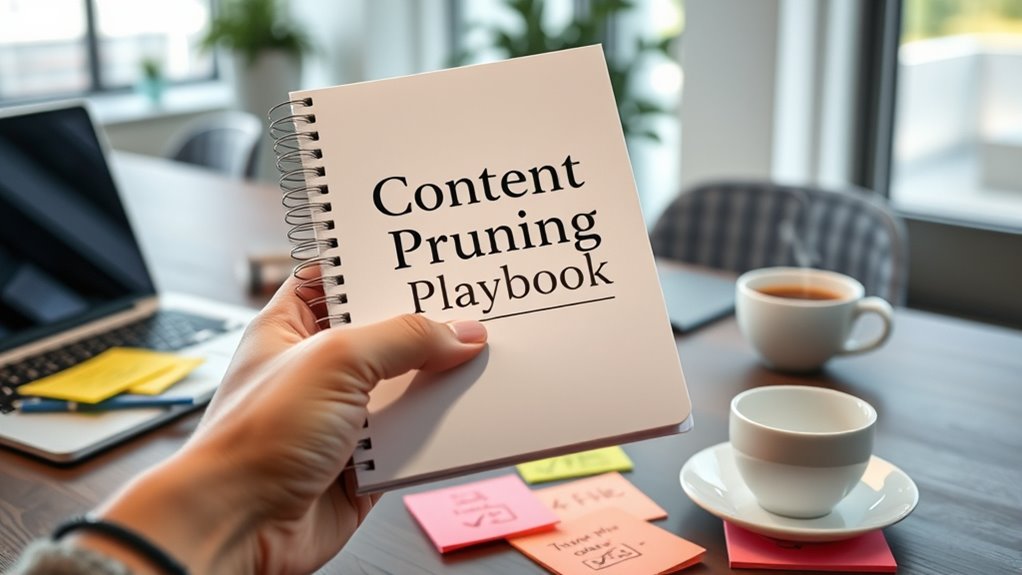The Content Pruning Playbook shows you when less truly ranks more by helping you cut clutter and focus on your best content. By removing low-performing, duplicate, or outdated pages, you boost your site’s authority and improve search engine rankings. Streamlining your site makes it easier for users to find what matters. Keep an eye on your analytics to see the impact, and if you want to master this strategy, learn more about effective pruning techniques ahead.
Key Takeaways
- Remove low-performing, thin, or duplicate content to improve overall site quality and search rankings.
- Consolidate similar pages to create more comprehensive, authoritative content.
- Streamline navigation and internal linking to highlight high-value pages and enhance user experience.
- Regularly analyze performance metrics to identify content that no longer aligns with business goals.
- View content pruning as an ongoing process to maintain a focused, relevant, and high-ranking website.

Have you ever wondered how to keep your website fresh and effective? It’s easy to think that adding more content is the way to grow your online presence, but sometimes, less truly is more. Content pruning—removing outdated, underperforming, or redundant pages—can boost your site’s overall quality and search engine rankings. When done strategically, pruning helps search engines understand what your site truly emphasizes, and it improves user experience by reducing clutter and confusion.
Simplify your website by removing outdated or redundant content to boost quality and improve search rankings.
The first step is identifying content that no longer serves your goals. You should analyze your website’s performance data to find pages with low traffic, high bounce rates, or those that generate little engagement. These pages often dilute your site’s authority and can hurt your SEO efforts. Don’t just look at raw numbers; examine how each page aligns with your current business objectives. If a page isn’t contributing to your goals, it’s a candidate for removal or consolidation. Remember, not every outdated page needs to be deleted—some can be updated or merged to create more extensive, valuable content.
Next, consider the quality of your remaining content. High-quality pages should be clear, relevant, and authoritative. When pruning, pay attention to duplicate content or pages with thin information that doesn’t add value. Removing or consolidating these pages helps search engines better understand your site’s core topics. Additionally, ensure that your most important pages are easy to find and accessible. Internal linking plays a fundamental role here—use it to direct visitors and search engines to your best content, reinforcing your site’s authority on key subjects.
A essential aspect of pruning is managing your site’s structure and navigation. Remove or update outdated links, and streamline your menus to highlight the most important pages. This not only improves user experience but also ensures that link equity flows efficiently to your top-performing content. Remember, every page you keep should have a purpose and contribute to your overall strategy. Don’t hesitate to delete pages that are no longer aligned with your brand or business goals.
Finally, after pruning, monitor your website’s performance carefully. Track changes in traffic, rankings, and engagement metrics. This feedback will help you refine your content strategy and identify whether further pruning is necessary. It’s a continuous process—regularly reviewing and trimming your content keeps your website lean, relevant, and authoritative. To support your efforts, utilizing tools like SEO analytics enables you to make data-driven decisions about what to prune or retain. When you embrace less but better content, you’re not just cleaning up your site; you’re making it smarter, more focused, and more appealing to both users and search engines.
Frequently Asked Questions
How Often Should Content Pruning Be Performed?
You should perform content pruning every three to six months to keep your site fresh and search rankings high. Regularly review your content to identify outdated, low-performing, or redundant pages. By pruning consistently, you guarantee your website stays relevant and valuable to users. Keep an eye on analytics to detect decline in performance, and don’t hesitate to remove or update content that no longer serves your goals effectively.
What Tools Can Assist in Content Pruning?
You can’t afford to ignore tools like Google Analytics, SEMrush, or Ahrefs—they’re your secret weapons for effective content pruning. These tools reveal which pages are dragging your site down or skyrocketing your rankings, making your job easier and more precise. Use them to identify outdated content, low-performing pages, and opportunities for improvement. With their help, you’ll prune smarter, boost your SEO, and watch your rankings soar like never before.
How to Identify Content Worth Removing?
You should analyze your content’s performance metrics like traffic, bounce rate, and conversion rates to spot underperformers. Look for outdated, duplicate, or low-value content that no longer serves your audience’s needs. Use tools like Google Analytics and Search Console to identify pages with low engagement. Prioritize removing or updating content that doesn’t align with your current goals, ensuring your site remains relevant and authoritative.
Does Pruning Negatively Impact SEO Rankings?
Pruning doesn’t necessarily hurt your SEO; in fact, it often improves it. Think of your website like a garden—removing weeds allows healthy plants to thrive. When you cut low-performing pages, search engines focus on your best content, boosting rankings. A case study showed a site that pruned 30% of its pages saw a 20% increase in organic traffic, proving less can be more when it comes to SEO.
How to Communicate Pruning Changes to Stakeholders?
You should clearly explain the reasons behind pruning, emphasizing how it improves overall site quality and SEO performance. Share data showing potential ranking boosts and reduced maintenance. Keep stakeholders informed by providing regular updates and success stories. Use visuals like charts to illustrate progress. Be transparent about risks and how you mitigate them. Ultimately, demonstrate that pruning aligns with broader goals, ensuring everyone understands its strategic benefits.
Conclusion
By removing the clutter and focusing on quality, you’re sharpening your website like a sculptor chiseling away to reveal a masterpiece. Content pruning might seem like shedding weight, but it actually gives your site the strength to rise higher in search rankings. Remember, less is often more—like a clear sky that lets the stars shine brightly. Embrace this strategy, and watch your site grow more focused, engaging, and powerful than ever before.









